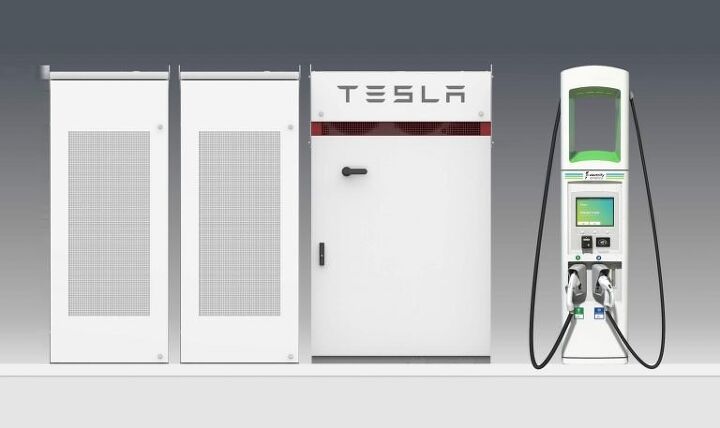Volkswagen's Electrify America Buying Tesla Hardware for EV Charging Stations

Volkswagen has agreed to spend $2 billion improving the United States’ adolescent charging infrastructure over the next 10 years as part its diesel-related agreement with federal regulators. As part of that arrangement, the automaker established Electrify America as the subsidiary responsible for most of the leg work.
While it invests heavily in the nation’s EV charging network and drops a few million here and there to raise ecological awareness and encourage the adoption of zero-emission vehicles, it also has to be careful to remain brand neutral.
None of Electrify America’s programs can be seen as catering to VW, resulted in some interesting bedfellows. Case in point, Electrify America just announced plans to install Tesla Inc battery storage packs at more than 100 charging stations across the U.S.
The goal, according to VW’s subsidiary, is to draw energy from the grid during off-peak hours (when it’s cheaper) and store it in Tesla’s storage units to be used by customers later.
“If you pass the demand charge onto the customer in a high-demand charge market [it could cost anywhere from $70 to $110 to fully charge one vehicle],” Electrify America’s chief operating officer, Brendan Jones, told Reuters in an interview. “If you did that, obviously nobody would buy an electric vehicle.”
Electrify America plans to install the battery packs in areas of the United States with higher concentrations of electric vehicles, specifically the coastal regions. Jone estimates the company will have 484 charging stations built across America by June, adding that Electrify America is discussing the roll-out of additional battery storage units with regulators for its next round of court-appointed investments. These will likely include more of the firm’s 350-kW fast chargers and additional sites in 42 states.
“Our stations are offering some of the most technologically advanced charging that is available,” Giovanni Palazzo, chief executive officer of Electrify America, said as part of the company’s corporate announcement. “With our chargers offering high power levels, it makes sense for us to use batteries at our most high demand stations for peak shaving to operate more efficiently. Tesla’s Powerpack system is a natural fit given their global expertise in both battery storage development and EV charging.”
[Images: Volkswagen Group]

A staunch consumer advocate tracking industry trends and regulation. Before joining TTAC, Matt spent a decade working for marketing and research firms based in NYC. Clients included several of the world’s largest automakers, global tire brands, and aftermarket part suppliers. Dissatisfied with the corporate world and resentful of having to wear suits everyday, he pivoted to writing about cars. Since then, that man has become an ardent supporter of the right-to-repair movement, been interviewed on the auto industry by national radio broadcasts, driven more rental cars than anyone ever should, participated in amateur rallying events, and received the requisite minimum training as sanctioned by the SCCA. Handy with a wrench, Matt grew up surrounded by Detroit auto workers and managed to get a pizza delivery job before he was legally eligible. He later found himself driving box trucks through Manhattan, guaranteeing future sympathy for actual truckers. He continues to conduct research pertaining to the automotive sector as an independent contractor and has since moved back to his native Michigan, closer to where the cars are born. A contrarian, Matt claims to prefer understeer — stating that front and all-wheel drive vehicles cater best to his driving style.
More by Matt Posky
Latest Car Reviews
Read moreLatest Product Reviews
Read moreRecent Comments
- MaintenanceCosts Poorly packaged, oddly proportioned small CUV with an unrefined hybrid powertrain and a luxury-market price? Who wouldn't want it?
- MaintenanceCosts Who knows whether it rides or handles acceptably or whether it chews up a set of tires in 5000 miles, but we definitely know it has a "mature stance."Sounds like JUST the kind of previous owner you'd want…
- 28-Cars-Later Nissan will be very fortunate to not be in the Japanese equivalent of Chapter 11 reorganization over the next 36 months, "getting rolling" is a luxury (also, I see what you did there).
- MaintenanceCosts RAM! RAM! RAM! ...... the child in the crosswalk that you can't see over the hood of this factory-lifted beast.
- 3-On-The-Tree Yes all the Older Land Cruiser’s and samurai’s have gone up here as well. I’ve taken both vehicle ps on some pretty rough roads exploring old mine shafts etc. I bought mine right before I deployed back in 08 and got it for $4000 and also bought another that is non running for parts, got a complete engine, drive train. The mice love it unfortunately.



































Comments
Join the conversation
I have some experience with commercial electricity accounts. The "distribution" charge is based on the peak demand in a month. If the peak can be reduced then there is a substantial reduction in this charge. Think of it as a rental charge for the power line capacity required to meet the customer's peak demand. Using a battery would enable this reduction by evening out demand.
What's this got to do with being brand-neutral? It's not like VW is installing Tesla-specific Superchargers. They're installing the same chargers they always do. They're just supplementing some of them with batteries that can suck up power at cheap off-peak rates for distribution later, and the company that makes the best batteries for that purpose happens to be Tesla. (Clickbait for the jump maybe?)